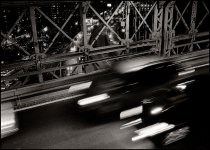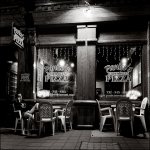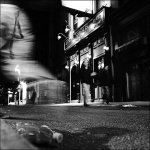NickTrop
Veteran
If you survey the photography books on the subject - say via Amazon reviews, you generally find a measure of disappointment. It's as if readers are expecting some kind of "revelation" but there's none to be had - the same general photographic principles apply, it seems, and so readers feel cheated.
I picked up a hardcover on the subject over the summer at a used book store, and I can see where readers might have had a gripe had I paid $50 for the text, rather than a few bucks.
I can't recall the title, author though he looked a bit like a monk... (it's around here somewhere!), and think it came out in the early to mid-90's. Like those who are critical of books on the subject, the author seemed to struggle filling up a text with an amount of information would be more appropriate for a one-page "tip" sheet.
However, there were a couple "take aways" from the book:
1. The author prefered a fast lens over high-speed film, seeming partial to 400 speed film. So, he suggests you get better results with 400 speed film and a solid f1.4 lens that preforms well wide open - than say, an f2.8 lens with 1600 speed film or even a faster lens with faster film, inferring you tend to push things beyond acceptable capabilities (1600 graininess + f1.4 = soft grainy image...)
2. The author liked the 1.4 focal length. He felt that faster lenses cost "silly money" and that they're not really practical for hand-held shots because of DOF issues.
Since reading this, I have to admit, I did agree. However, I would up the film speed to 800 asa - and rarely use faster speeds. Where I do use (or rate/develop) beyond this has more to do with focal length. For example, I have 1600 Fuji in my SLR right now because I have an 85mm Jupiter 9 on the camera and need to shoot at 1/125 due to the focal length. I want to take some available light portraits with the set-up.
Do you agree with these recommendations? Does anyone have any other tips or opinions for getting best results in available darkness?
Thanks all,
Nick
I picked up a hardcover on the subject over the summer at a used book store, and I can see where readers might have had a gripe had I paid $50 for the text, rather than a few bucks.
I can't recall the title, author though he looked a bit like a monk... (it's around here somewhere!), and think it came out in the early to mid-90's. Like those who are critical of books on the subject, the author seemed to struggle filling up a text with an amount of information would be more appropriate for a one-page "tip" sheet.
However, there were a couple "take aways" from the book:
1. The author prefered a fast lens over high-speed film, seeming partial to 400 speed film. So, he suggests you get better results with 400 speed film and a solid f1.4 lens that preforms well wide open - than say, an f2.8 lens with 1600 speed film or even a faster lens with faster film, inferring you tend to push things beyond acceptable capabilities (1600 graininess + f1.4 = soft grainy image...)
2. The author liked the 1.4 focal length. He felt that faster lenses cost "silly money" and that they're not really practical for hand-held shots because of DOF issues.
Since reading this, I have to admit, I did agree. However, I would up the film speed to 800 asa - and rarely use faster speeds. Where I do use (or rate/develop) beyond this has more to do with focal length. For example, I have 1600 Fuji in my SLR right now because I have an 85mm Jupiter 9 on the camera and need to shoot at 1/125 due to the focal length. I want to take some available light portraits with the set-up.
Do you agree with these recommendations? Does anyone have any other tips or opinions for getting best results in available darkness?
Thanks all,
Nick





